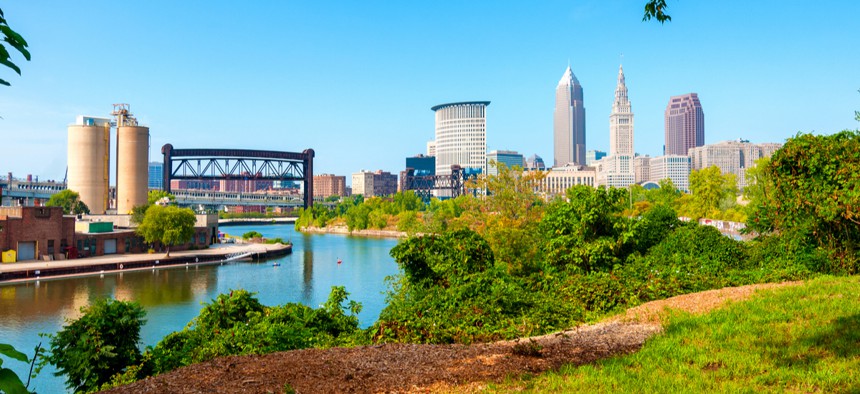Midwest Cities Among the Worst Places to Live for African Americans

Cleveland is on the list of the top six metropolitan areas where poverty among black residents exceeds 40%, along with four other Midwestern cities. Shutterstock
A new report finds that the Midwest has some of the highest racial disparities in the country across factors like education, employment, income, homeownership, and access to healthcare.
The Midwest is experiencing a renaissance of sorts. As coastal cities like New York, San Francisco, and Washington, D.C. become increasingly unaffordable, overlooked locales are seeing new spotlights shone on them. Cleveland has become a hub for craft breweries. Milwaukee entrepreneurs are building a sizeable collection of local startups. Detroit has one of the highest rates of millennial homeownership.
But beyond being elevated on listicles celebrating their amenities or relatively low costs of living, these cities have another thing in common: They all made a new list of the top six metropolitan areas where poverty among black residents exceeds 40%. Two other Midwestern cities, Dayton, Ohio and Gary, Indiana, are also in the top six.
A report released this month by a group of progressive economic policy groups finds that black-white disparities are stark in the Midwest, and remain so across a variety of measures. The report’s authors conclude that historic, economic and political factors have cemented a black-white gap in the areas of employment, access to healthcare, built wealth, income, rates of homeownership, poverty, and education—and that gap is particularly significant in the Midwest, where 91.4% of residents identify as either black or white.
Colin Gordon, a professor at the University of Iowa and the author of the report, noted in a press release the disconnect between the celebration of Midwestern states and cities as affordable, given that the benefits they provide aren’t equally distributed. “While many Midwestern cities appear in viral ‘best places to live’ lists, they are also among the very worst places to live for African Americans,” said Gordon. “These patterns of stark discrimination and vast racial disparities have long-lasting impacts on families of color in the Midwest.”
The report, a project of the Iowa Policy Project, Policy Matters Ohio, the Center on Wisconsin Strategy, and the Economic Policy Institute, points to the fact that ten Midwestern states, along with neighboring Pennsylvania, made up the eleven states with the largest gap between rates of black and white unemployment in 2017.
The disparities are present in other significant statistics, as well. Six Midwestern states—Illinois, Kansas, Iowa, Nebraska, Minnesota, and Wisconsin—suspend black students at rates more than five times that of white students. Every Midwestern state imprisons African Americans five times more often than whites.
The Center on Wisconsin Strategy called the racial disparities “extreme” in a state where white residents are twice as likely to hold a college degree than black residents. In Wisconsin, only 27% of black families own their home, compared to 70% of white families, while the mortality rate of black babies is the worst in the nation. The group wrote that “racial disparity in Wisconsin is not inevitable. Thirty years ago the state generated much better economic outcomes for blacks who, on average, did better in Wisconsin than the national average.”
Wisconsin has a similar story to many of the other states in the report. Many black residents of the Midwest arrived in the region during the Great Migration—a time when seven million African Americans fled the oppression of the South’s Jim Crow laws looking for employment in northern industrial centers. While the 1960s and 1970s saw the passage of civil rights laws and improvements in many black residents’ standard of living, policies of that era that restricted their ability to make serious economic gains have also had lasting impacts.
When deindustrialization hit, black workers were often fired first, creating heavily concentrated pockets of poverty. Discrimination in housing and employment has led to a significant racial wealth gap, while unemployment rates for black workers have remained nearly double that of white workers. Racial segregation in schools has actually increased over the past few decades.
The report notes that black residents of the Midwest, despite dealing with many problems in their communities, are often excluded from conversations about reviving the region. Instead, many politicians have focused on the white working class, discussions the report says “starkly misrepresent a region that is home to over 7 million African Americans.”
So before the Midwest tries to become the next Silicon Valley, Gordon urged states and cities to focus on providing better opportunities for black residents by investing in public education to create a more diverse teacher workforce, raising the minimum wage, improving access to public benefits, addressing housing discrimination, and making life easier for families through paid parental leave and low cost childcare. “A strong policy agenda that views racial equity as a fundamental goal can turn our region around,” he said.
Naomi Walker, director of the Economic Analysis and Research Network at EPI, agreed. “It’s time for policymakers to fully recognize the economic harm that structural racism has caused black families in all parts of the country,“ she wrote. “In a time of federal inaction, states must step up to address disparate economic outcomes.”
Emma Coleman is the assistant editor for Route Fifty.
NEXT STORY: Your Neighbor’s Christian Education, Courtesy of Your Tax Dollars






